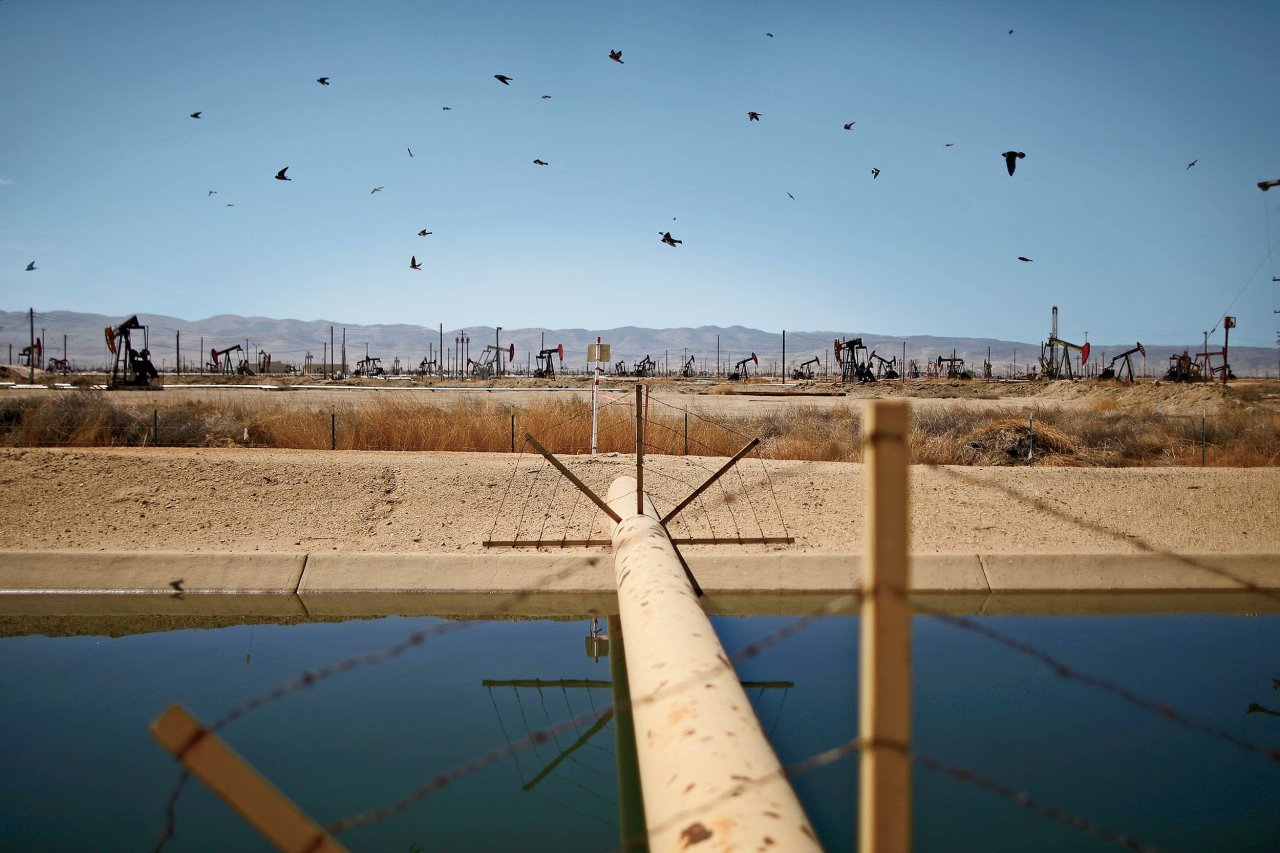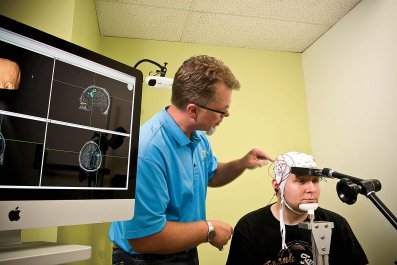If you jabbed at the center of a map of Oklahoma, your finger might land on Jones City, population 2,500. "Just a little piece of Americana," as Lewis Moore, the state representative for the area, calls it—Main Street has a firehouse, a pharmacy and a Sonic Drive-In, and beyond downtown are vast, flat fields of pasture. Jones City also happens to be at the epicenter of an unprecedented spate of earthquakes. From 1978 until 2008, Oklahoma averaged only two earthquakes over magnitude 3.0 per year; midway through 2014, the state has already registered 230 quakes of that strength, easily surpassing California as the most earthquake-prone state in the country.
These quakes seem to be induced by a step in the hydraulic fracturing process—the disposal of vast volumes of salty, chemical-laced wastewater by injecting it deep into the ground. Texas, Arkansas and Ohio have also recently seen spikes in earthquakes in the vicinity of wastewater injection wells. The tremors are unprecedented—they are making ground shake that scarcely did before—and the evidence pointing to fracking disposal is piling up. But Moore is skeptical. "The Earth, and the science of how everything works, is so big. We are so minute," he says. "For us to think that we have so much to do with these things is almost ludicrous."
We've heard the same sentiment before: Humans are too small to warm the Earth or raise the sea level. Earthquakes may be the next addition to that category. As long as elected officials, like Moore, hold the same view, little will be done.
Humans have always had trouble understanding those aspects of existence that are monumental in scope. For most of our history, all larger-than-life natural phenomena have required the explanatory assistance of other equally larger-than-life forces. Gods expressed their approval with good weather, and their wrath with droughts, tempests or fires. Or earthquakes.
In the second century A.D., the Roman emperor Trajan found himself climbing out a window of a shaking building, escaping a crushing death as the ancient city of Antioch crumbled. Trajan concluded that the spread of Christianity angered the Roman gods and brought on the massive quake, so he sent Ignatius, the bishop of Antioch, to be eaten by lions in the Colosseum.
Sixteen hundred years later, when the devastating earthquake of 1755 struck Lisbon, Portugal, there was a strong feeling in Protestant countries that the disaster was holy punishment for the idolatry of the city's Catholic majority. "The headquarters of the Inquisition was one of the first things to be flattened, while the red light district was unscathed," disaster historian John Withington tells Newsweek. "It caused a lot of mirth in Protestant countries."
Today, rationalizing earthquakes along religious lines is mostly a fringe pursuit—for example, Pat Robertson, the reliably inflammatory Southern Baptist minister, blamed the 1994 San Fernando Valley earthquake, which killed 72, on God's displeasure with gays and pro-choice activists, according to The Advocate.
But despite the fact that God has largely been removed from the equation, a mysticism about earthquakes persists. Whether it's an act of God or a force of nature, earthquakes are, for the most part, out of our hands. The prospect, then, that we might play a role in causing them is difficult for some to comprehend.
University of Texas at Austin seismologist Cliff Frohlich understands the intellectual challenge. "When you start thinking about it, you think, How can we as puny little humans do that?" he asks. But, he adds, we can. And do.
A few years ago, not even scientists working in the fracking industry believed Frohlich when he said fracking fluid disposal wells could induce earthquakes. Frohlich, who has now published almost 20 papers on the subject, said he was all but laughed at whenever he'd bring it up. Many researchers in the field had never encountered the problem, and thought the idea was ridiculous. After all, of the 10,000 active injection wells in Texas, "only 20 or so have caused quakes," he says. But the amount of fluid injected has skyrocketed in recent years as the fracking boom has soared to new heights.
And the evidence of induced earthquakes speaks for itself. "[Fracking scientists] acknowledge that it can happen now," Frohlich says. "That's just over the last five years."
The seismology community has known for decades that humans can induce earthquakes simply by filling a large reservoir. The abrupt change in tectonic stress from the water's weight can cause a fault to "slip." In 1967, the newly filled Koyna reservoir about 100 miles south of Mumbai was believed to have triggered a quake that flattened a nearby village, killing 200 people and leaving more than 5,000 homeless. Researchers say the magnitude-7.9 disaster that struck China's Sichuan Province in 2008, killing 69,000 people, may have been caused by the recently completed Zipingpu Dam.
While man-made quakes can be devastating, the ones tied to disposal wells tend to be small and innocuous, typically under a magnitude 3, which, even at the epicenter, might at most make dishes rattle or picture frames swing. But in Oklahoma in 2011, a magnitude-5.7 injection-induced earthquake—the strongest in the state's history—destroyed 13 homes and injured two. The same year, Arkansas was hit with a magnitude-4.7 quake, along with thousands of other smaller tremors, causing the state to place a moratorium on injection wells. The frequency of the earthquakes declined, and the moratorium is still in place.
"You don't want to be too hysterical about induced earthquakes," Susan Hough, a seismologist at the U.S. Geological Survey (USGS), says, noting that despite the many earthquakes, very few have caused damage. But, she adds, "we don't know how big these earthquakes can be, or what the limit is." And even a small earthquake has the potential to do significant damage if it happens in the wrong place, like a densely populated area with poor building codes. In 1986, a magnitude-5.7 earthquake in El Salvador's capital city of San Salvador—the same magnitude as the 2011 Oklahoma quake—killed 1,500 people.
"People want answers. People want to know if an earthquake is going to happen or not, and we just can't give them that," Hough says. "We don't really understand the full hazard associated with this."
Humans haven't been injecting large quantities of liquid underground for long, and scientists don't know much about the impact of the process on the earth. Perhaps the first glimmer of proof that it can cause quakes came in the 1960s, when thousands of earthquakes in Colorado were tied to the U.S. government's Rocky Mountain Arsenal, a chemical weapons manufacturing plant where the Army manufactured sarin nerve gas.
In March 1962, the Army began injecting waste from chemical operations down a 12,000-foot well at the arsenal. One month later, small earthquakes began hitting the Denver region, northeast of the plant. By the end of December 1962, the area registered 190 minor earthquakes, but little attention was paid, except to note that the area had never been particularly seismic before.
Between January 1963 and August 1967, the area shook with another 1,300 earthquakes, three of which were strong enough to damage property, according to the USGS. One quake caused all Boulder-area schools to temporarily close and legislators to evacuate areas of the Denver capitol where light fixtures on the ceiling were deemed a danger.
The Army closed the well in 1966 "because of the possibility that the fluid injection was triggering earthquakes," according to the Army's Remediation Venture Office.
Despite this, research on induced earthquakes was sparse. But now, as newly rumbling states demand answers, the field is exploding. "Before, there'd be one paper [coming] out about [induced earthquakes] every so often. Now a couple dozen papers come out every month," Frohlich says. "It's what we're all working on. We're still at the stage where the rules that work in one area won't work in another. We don't have a comprehensive understanding of what causes these quakes—near one well it happens, near another it doesn't."
As seismologists scramble to understand these earthquakes, convincing the public—and the energy industry—that humans may be behind them has been nearly impossible. Hough brings up climate change as a comparison. Despite the fact that "climate change is to the point [where] there's no major dissent in the scientific community," many people still don't believe it's real. "There's a lot more uncertainty with earthquakes," Hough says, and "we're trying to communicate with imperfect knowledge."
Glen Brown, the vice president of geology at Continental Resources, one of the biggest petroleum liquids producers in Oklahoma, isn't having any of it. "I believe that what's going on in Oklahoma today is [a] natural swarm [of earthquakes] of very small magnitude and very small impact," Brown told IBTimes. "Quite frankly, the way that people are talking about it is over-exaggerating what's going on." Whether by declaring hyperbole or fantasy or both, energy companies and state officials are quick to wave away the notion of induced quakes.
But regardless of how Brown, Moore and others like them see it, the ground is rumbling, and humans are a big reason why. "We are affecting that system. The question is how much," Hough says. As the U.S. fracking boom reaches unprecedented heights, the science of its consequences is racing to catch up. "We're kind of doing an experiment that we've never done before."






























